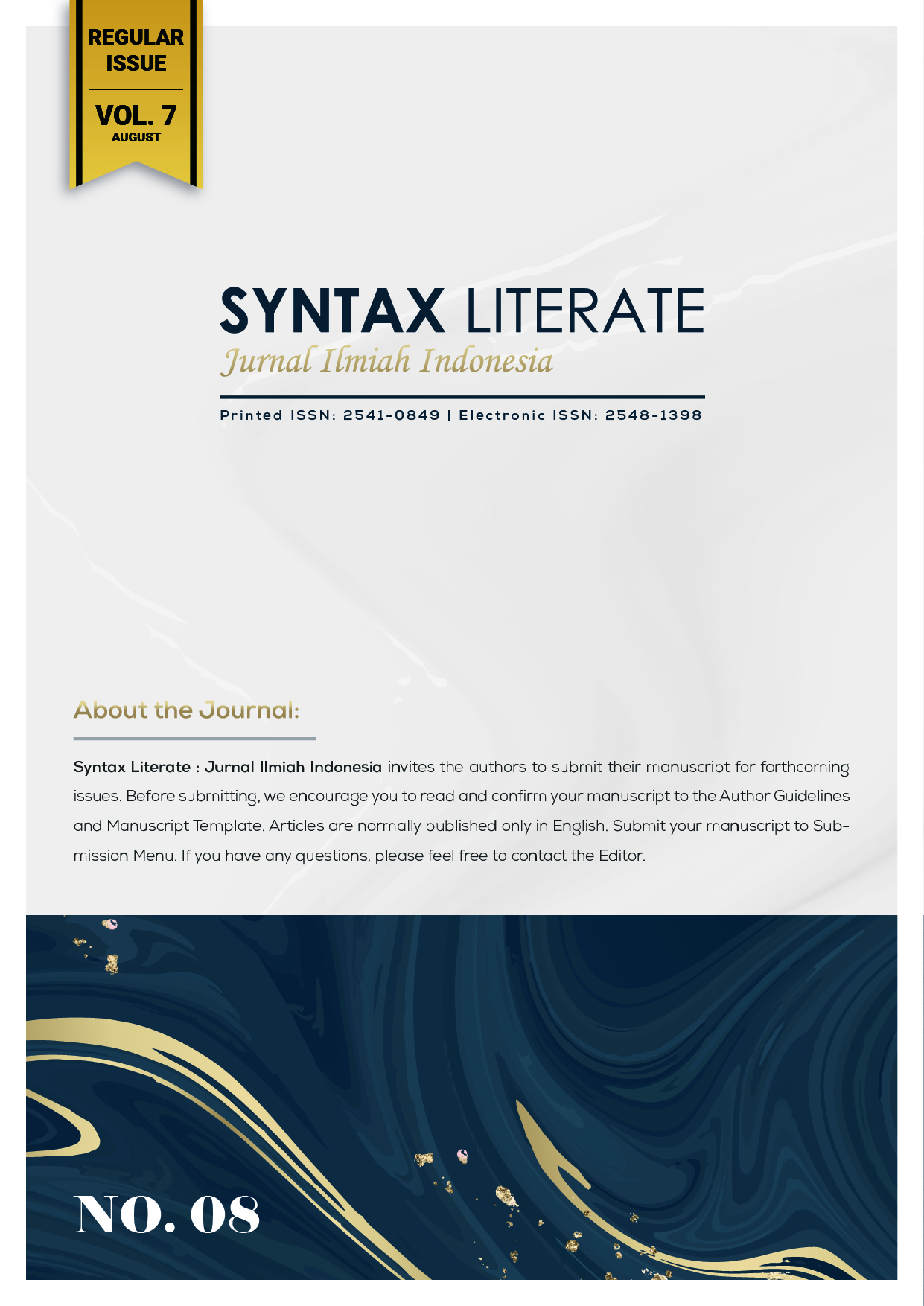The Disclosure Obligation of Sustainability Reports In The Banking Sector In Indonesia: A Descriptive Analysis
Abstract
Sustainability reporting is a tool for communicating the company's environmental and social reports. This study was conducted to examine how far the sustainability reports are disclosed by banks in Indonesia. Banking sustainability reports in Indonesia have been required by banking regulations since 2019. The analysis is carried out by looking at the development of banking sustainability reports and also conducting different tests before and after the implementation of mandatory sustainability reporting in banking sector. The results show that banks in Indonesia have started making sustainability reports since 2009. Total banks that disclosed sustainability reports experienced a significant increase in 2019 (22.61%) and decreased in 2020 (14.78%). The results also show that there is no difference in banking disclosures on sustainability reports between before and after obligations, that is 2 years before disclosure obligations (2017-2018) and 2 years after disclosure (2019-2020).
Downloads
References
Brundtland, G. H. (1987). Report of the World Commission on environment and development:" our common future.": UN.
Chaklader, B., & Gulati, P. A. (2015). A study of corporate environmental disclosure practices of companies doing business in India. Global Business Review, 16(2), 321-335.
Dalal-Clayton, D. B., Bass, S., & Swingland, I. R. (2002). Sustainable development strategies: a resource book: Earthscan London.
Dernbach, J. C. (2003). Achieving sustainable development: The Centrality and multiple facets of integrated decisionmaking. Global Legal Studies, 10(1), 247-284.
Elkington, J. (1997). The triple bottom line. Environmental management: Readings and cases, 2.
Eluyela, F., Adetula, D. T., Oladipo, O., Nwanji, T. I., Adegbola, O., Ajayi, A., & Faleye, A. (2019). Pre and post adoption of IFRS based financial statement of listed small medium scale enterprises in Nigeria. International Journal of Civil Engineering and Technology (IJCIET), 10(1), 1097-1108.
Escrig-Olmedo, E., Muñoz-Torres, M. J., & Fernandez-Izquierdo, M. A. (2010). Socially responsible investing: sustainability indices, ESG rating and information provider agencies. International journal of sustainable economy, 2(4), 442-461.
Ferri, G., & Acosta, B. A. (2019). Sustainable Finance for Sustainable Development. Retrieved from
Global Reporting Initiative, G. (2011). Sustainability reporting guidelines version 3.1. Amsterdam, The Netherlands: Global Reporting Initiative.
Guidry, R. P., & Patten, D. M. (2010). Market reactions to the firstâ€time issuance of corporate sustainability reports: Evidence that quality matters. Sustainability Accounting, Management and Policy Journal.
Gupta, S., & Mohanty, S. (2014). Convergence of cost accounting standards (CASs) and national voluntary guidelines (NVGs). The Management Accountant Journal, 49(11), 90-92.
IAI. (2009). Pernyataan standar akuntansi keuangan. Jakarta: Salemba Empat.
Ihlen, Ø., & Roper, J. (2014). Corporate reports on sustainability and sustainable development:‘We have arrived’. Sustainable development, 22(1), 42-51.
Isaksson, R., & Steimle, U. (2009). What does GRIâ€reporting tell us about corporate sustainability? The TQM Journal.
Islam, M. A., Jain, A., & Thomson, D. (2016). Does the global reporting initiative influence sustainability disclosures in Asia-Pacific banks? Australasian Journal of Environmental Management, 23(3), 298-313.
Jeucken, M. (2010). Sustainable finance and banking: The financial sector and the future of the planet: Routledge.
Jizi, M. I., Salama, A., Dixon, R., & Stratling, R. (2014). Corporate governance and corporate social responsibility disclosure: Evidence from the US banking sector. Journal of business ethics, 125(4), 601-615.
Khan, S., Khan, M., Hanjra, M. A., & Mu, J. (2009). Pathways to reduce the environmental footprints of water and energy inputs in food production. Food policy, 34(2), 141-149.
Lozano, R. (2006). A tool for a Graphical Assessment of Sustainability in Universities (GASU). Journal of cleaner production, 14(9-11), 963-972.
Lozano, R., & Huisingh, D. (2011). Inter-linking issues and dimensions in sustainability reporting. Journal of cleaner production, 19(2-3), 99-107.
Lozano, R., & Young, W. (2013). Assessing sustainability in university curricula: exploring the influence of student numbers and course credits. Journal of cleaner production, 49, 134-141.
Mitra, N., & Schmidpeter, R. (2017). The why, what and how of the CSR mandate: The India story. In Corporate Social Responsibility in India (pp. 1-8): Springer.
Munasinghe, M. (1993). Environmental economics and sustainable development (Vol. 3): World Bank Publications.
Nations, U. (2019). More money needed to implement Sustainable Development Goals, SecretaryGeneral tells ECOSOC Financing for Development Forum, calling 2019 “Defining Yearâ€. Retrieved from https://www.un.org/press/en/2019/sgsm19546.doc.htm
OJK. (2015). Roadmap Keuangan Berkelanjutan Tahap I Tahun 2015-2020. Jakarta, Indonesia: Otoritas Jasa Keuangan
POJK Nomor 6/POJK. 03/2016 Tentang Kegiatan Usaha dan Jaringan Kantor Berdasarkan Modal Inti Bank, (2016).
Peraturan Otoritas Jasa Keuangan Nomor 51/POJK. 03/2017 Tentang Penerapan Keuangan Berkelanjutan Bagi Lembaga Jasa Keuangan, Emiten, dan Perusahaan Publik, (2017).
OJK. (2021). Roadmap Keuangan Berkelanjutan Tahap II Tahun 2021-2025. Jakarta, Indonesia
Puaschunder, J. M. (2017). Financing Climate Justice Through Climate Bonds. Oxford Journal on Finance and Risk Perspectives, 6(3), 1-10.
Roca, L. C., & Searcy, C. (2012). An analysis of indicators disclosed in corporate sustainability reports. Journal of cleaner production, 20(1), 103-118.
Sahoo, P., & Nayak, B. P. (2007). Green banking in India. The Indian Economic Journal, 55(3), 82-98.
Schoenmaker, D. (2017). Investing for the common good: A sustainable finance framework. Brussels: Bruegel, 80.
Siew, R. Y. (2015). A review of corporate sustainability reporting tools (SRTs). Journal of environmental management, 164(1), 180-195.
Stoddart, H. (2011). A Pocket guide to sustainable development governance.
Tauringana, V. (2020). Sustainability reporting challenges in developing countries: towards management perceptions research evidence-based practices. Journal of Accounting in Emerging Economies.
Wilson, J., Tyedmers, P., & Pelot, R. (2007). Contrasting and comparing sustainable development indicator metrics. Ecological indicators, 7(2), 299-314.
Ziolo, M., Filipiak, B. Z., Bąk, I., Cheba, K., Tîrca, D. M., & Novo-Corti, I. (2019). Finance, sustainability and negative externalities. An overview of the European context. Sustainability, 11(15), 4249.
Copyright (c) 2022 Rudy Hartanto, Irena Paramita Pramono, Riyang Mardini, Dwi Rahayu

This work is licensed under a Creative Commons Attribution-ShareAlike 4.0 International License.











